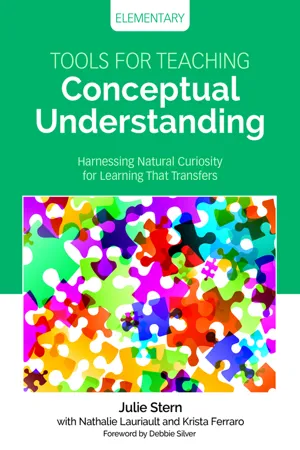
Tools for Teaching Conceptual Understanding, Elementary
Harnessing Natural Curiosity for Learning That Transfers
- 208 pages
- English
- ePUB (mobile friendly)
- Available on iOS & Android
Tools for Teaching Conceptual Understanding, Elementary
Harnessing Natural Curiosity for Learning That Transfers
About This Book
Harness natural curiosity for conceptual understanding! Young children are naturally curious, asking deep questions about complex concepts. This tendency is a talent that can be nurtured so that children grow to be deep thinkers and innovators later in life. However, in our complex world, it is impossible to teach students everything they need to know. Pushing more factual content ignores what we know about how children learn and endangers their love of learning. Concept-based teaching helps young learners uncover conceptual relationships in a way that is developmentally appropriate. Readers of this guide will learn: • Why conceptual learning is a natural fit for children
• Strategies for introducing conceptual learning
• Instructional strategies to help students uncover and transfer concepts
• How to write lessons, assess understanding, and differentiate in a concept-based classroom
• How concept-based teaching aligns with best practices and initiatives Written for educators who strive to cultivate conceptual understanding while honoring students' innate curiosity, this is a must-have road map for implementing concept-based teaching in elementary classrooms. "This book provides the research and resources educators need to help students take ownership of their learning. It fosters students' curiosity about their environment and it allows them to explore and become life-long learners."
Ellen Asregadoo, Fifth Grade Teacher
Public School 190, Brooklyn, NY "This is an important book for all teachers. We need to be honoring our students as thinkers who deserve developmentally appropriate intellectual rigor in the classroom. We will not achieve this in our traditional coverage based classroom. I am so inspired and can't wait to start this journey (making mistakes and learning along the way!)."
Sarah Gat, Second Grade Teacher
Ecole Arbour Vista Public School, Guelph, Ontario
Frequently asked questions
Information
Table of contents
- Cover
- Acknowledgements
- Half Title
- Series
- Title Page
- Copyright Page
- Contents
- Foreword
- Acknowledgments
- About the Authors
- Introduction: Why Is Concept-Based Curriculum Critical for the 21st Century?
- Chapter 1 What Are the Essential Elements of Concept-Based Curriculum Design?
- Chapter 2 How Do I Set Up My Classroom for Deep, Conceptual Learning?
- Chapter 3 What Are the Building Blocks of Concept-Based Instruction?
- Chapter 4 What Additional Tools Can We Use to Design Lessons?
- Chapter 5 How Do We Design Assessments for Conceptual Understanding?
- Chapter 6 How Can We Work Toward Equity in a Concept-Based Classroom?
- Chapter 7 How Can Conceptual Understanding Help to Preserve a Love of Learning Beyond Childhood?
- Conclusion: Imagine What School Could Be…
- References
- Index
- Advertisement